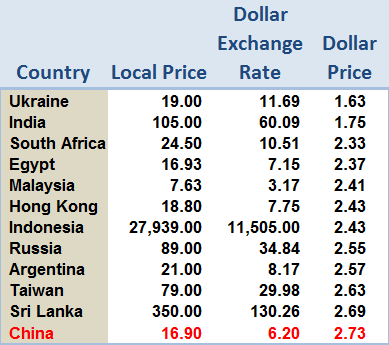

The median is just under 7,000 yuan per square meter. The following figure shows our provincial housing price index. We adjusted the average city price index within each province by each respective provincial CPI and used this number as a measure of the real cost of living. We used a housing price index of over 100 Chinese cities to construct a provincial housing price index. Since a large share of income is typically spent on housing, living standards can be greatly affected (adversely) by housing prices. Given a fixed level of income, the higher the cost of living, the lower the living standard. Obviously, income is only one aspect of living standards, while the cost of living is another. This breakdown begins to show regional wealth inequality within China, but still does not fully capture inequality within each province, which requires finer micro data. This was especially true for Beijing and Shanghai, where real per capita household disposable income was around 48,000 yuan, or about four times the level of the lowest income regions. Indeed, the figure shows that income was significantly skewed toward a few provinces. Nonetheless, the average income was still significantly higher than the median. The average was 21,586.95 yuan, and the median was 18,371.34 yuan, suggesting that income inequality is not as severe in China as it is in the world. We used a provincial-level consumer price index (CPI) to obtain real disposable income for different provinces across China. Disposable income is a person’s total income less taxes. To gauge the income distribution in China across regions, we next looked at real per capita household disposable income for 2015 by provinces. The figure shows that China’s average real per capita income is $12,472.51, which is in line with the world median income but far below the world average. However, since the measure is based on the average income of each nation, it does not capture inequality in living standards within a nation. This measure can be a useful way to compare living standards across the world. The large difference between the average and the median income means that world income is concentrated in a few rich countries, thus suggesting a high level of global inequality. The figure below shows real per capita GDP across the world in 2014 in terms of the dollar in 2011 at chained purchasing power parities.įor the world as a whole, average real per capita GDP was $20,055.65, while the median figure was $12,981.40.

Real per capita GDP is the average amount of goods and services produced per person in a nation in a given year at constant prices.

In this post, we’ll look at a few of them to analyze income and living standards across China.Ī common measure for gauging the living standard of a nation is real per capita gross domestic product (GDP). There are many ways to measure income and cost of living. By Yi Wen, Assistant Vice President and Economist, and Brian Reinbold, Research Associate


 0 kommentar(er)
0 kommentar(er)
